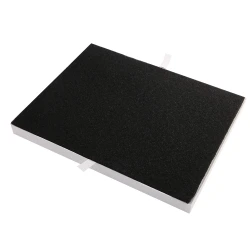Features and considerations related to activated carbon filters
2023-11-27
Activated carbon filters, also known as charcoal filters, are a type of air and water purification technology that uses a form of carbon with a high surface area to adsorb impurities. Here are key features and considerations related to activated carbon filters:
Characteristics of Activated Carbon Filters:
1. Adsorption Process:
- Unlike absorption, where a substance is taken in and retained by another, adsorption involves particles adhering to the surface of the adsorbent. Activated carbon has a highly porous structure, providing a large surface area for adsorption.
2. Material Composition:
- Activated carbon is a form of carbon that has been processed to have a large surface area per unit volume. It is often derived from materials like coconut shells, wood, or peat.
3. Particle Size Filtration:
- Activated carbon is effective at capturing larger particles, but its primary strength lies in adsorbing gases, odors, and chemicals from the air or water.
4. Gas and Odor Removal:
- Activated carbon filters excel at removing volatile organic compounds (VOCs), odors, and other gaseous pollutants from the air.
5. Complement to HEPA Filters:
- Activated carbon filters are often used in conjunction with HEPA filters in air purifiers. While HEPA filters capture particles, activated carbon adsorbs gases and odors.
6. Water Filtration:
- Activated carbon filters are commonly used in water purifiers to remove impurities, chlorine, bad tastes, and odors. They can also reduce the presence of certain chemicals.
7. Chemical Binding:
- Activated carbon has the ability to chemically bind certain contaminants, enhancing its effectiveness in removing specific pollutants.
8. Regeneration:
- Some activated carbon filters can be regenerated by exposing them to high temperatures or chemicals, restoring some of their adsorptive capacity.
Considerations:
1. Limited Particle Size Filtration:
- Activated carbon filters are not as effective at capturing fine particles like dust and allergens. They are more focused on gases and odors.
2. Replacement Frequency:
- Activated carbon filters have a finite adsorption capacity, and their effectiveness diminishes over time. Regular replacement is necessary for optimal performance.
3. Filter Thickness:
- The thickness of the activated carbon layer in a filter can affect its adsorption capacity. Thicker layers generally provide longer contact time for adsorption.
4. Mesh Size:
- The size of the carbon particles and the mesh size of the filter affect the types and sizes of contaminants that can be effectively adsorbed.
5. Pore Size:
- Activated carbon filters with a variety of pore sizes can capture a range of pollutants. Micropores are effective for smaller molecules, while mesopores and macropores target larger contaminants.
6. Application Specificity:
- Activated carbon filters can be tailored for specific applications, such as removing specific chemicals or targeting certain odors.
Activated carbon filters are versatile and play a crucial role in improving air and water quality. When choosing a purifier or filter with activated carbon, it's essential to consider the specific pollutants you want to address and the overall filtration system in use. Regular maintenance and replacement are key to ensuring continued effectiveness.



